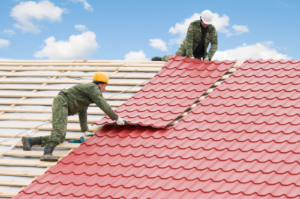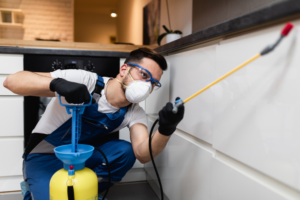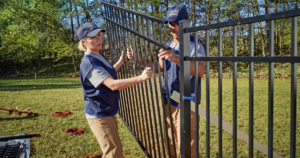Roofs protect buildings from weather and provide shelter for inhabitants. They come in a wide variety of shapes and sizes. There are even roofs made from plants!
In general, the higher the pitch of a roof, the more snow and rainfall it can withstand. The traditional thatch roofs of Papua New Guinea, for instance, are very steep. Contact Erie Roofing now!

Choosing the right roofing materials is one of the most important decisions to make when remodeling your home. The type of material you choose will have a significant impact on the overall appearance and value of your property. When deciding on a roofing material, it’s crucial to consider factors like cost, durability, and climate.
Asphalt shingles are the classic roofing material seen on most homes. They are durable, affordable, and easy to install. However, they don’t add as much to the resale value of your home as other roofing materials.
Concrete and clay tiles are another durable option that can look similar to other roofing materials. They’re great for warm and dry climates, but require extra support due to their weight and are prone to cracking if they’re exposed to extreme temperatures.
For those looking for a modern alternative, metal is an excellent choice. Steel or aluminum shingles or shakes are fabricated to look like traditional asphalt shingles, slate, and even wood. They’re also long-lasting, with a lifespan of 30 to 50 years.
Rolled roofing is a simple, inexpensive option for low-slope roofs. It’s made of long rolls of mineral-impregnated and asphalt-impregnated material topped with a layer of granules. It’s often used for outbuildings like sheds, and can be applied using a torch-down method or with roofing nails.
A membrane roof is a popular option for flat or low-slope roofs. Most commonly made with EPDM, it’s reliable, affordable, and easy to install and repair. It’s also waterproof and energy-efficient, making it an excellent choice for those who want a durable, attractive, and low-maintenance roof.
Natural roofing materials are becoming more popular among homeowners who want a greener home. Options include straw, hay, rice straw, and raffia palm leaves. These are biodegradable and sustainable, but they don’t provide the same weather protection as other roofing materials.
Other natural roofing materials include coconut shells, coir fibers, seagrass, and thatching reed. These are less durable than other roofing materials, but they’re environmentally friendly and can be aesthetically pleasing.
Installation
Roofing installation is a lengthy and labor intensive process. First, roofers must prepare the site. This includes covering surrounding landscaping, placing tarps and moving furniture to ensure that the work area is safe and free of debris. It also involves stripping off existing shingles, underlayment and decking. This can be a messy job and requires specialized equipment to avoid damaging the underlying structure.
Once the site is ready, the actual shingle installation begins. A shingle is made of two different materials that are bonded together with an adhesive starter strip. The strip provides a watertight seal that defends against leaks and other damage.
Contractors will then apply the first row of shingles and nail them firmly in place. They will overlap the first row by about six inches and then nail them in a pattern that starts close to the edge of the shingle and moves farther toward the center. They will repeat this pattern for the rest of the roof, ensuring that all areas are properly covered.
Finally, the roofers will waterproof the valleys, which are the areas where the roof meets the slopes. This can be done by applying underlayment and felt paper in a manner that is specific to the valley’s needs.
Roofing contractors must also perform other duties, including scheduling meetings with customers, managing supplies and equipment and handling accounting items such as payroll. They must also conduct inspections and walk the customer through their finished roof to ensure that it is up to standards.
Maintenance
Roofing is a big business, and it’s a job that requires many skills. A commercial or residential roof provides protection from the elements, and it’s an important part of a building’s structure. It also helps keep the interior comfortable. Whether the roof is made of shingles, metal or another material, it must be maintained properly to prevent leaks and other damage.
A good maintenance routine starts with regular inspections. Trained roofing professionals should perform these regularly (ideally on a biannual basis) to catch problems early and avoid expensive repairs. Roof inspections should include a thorough walk through to look for signs of damage and unusual wear. The professional should also look at the condition of the flashing (a strip of sheet metal that seals the edge where two sections meet) and around chimneys, vent pipes and skylights. He or she should check the caulk for cracking, openings and deterioration; these problems can lead to water leaks.
A roof should be free of debris, especially twigs, leaves and dirt that can retain moisture and promote the growth of mold and algae. Field drains should be clear to ensure they can carry water away from the roof surface. A clogged drain can cause localized ponding that can prematurely damage a roof and lead to structural damage. A roofing professional can recommend the appropriate maintenance tasks based on each roof’s unique requirements. For example, a low-sloped shingle roof might require frequent cleaning and resealing. A steep-sloped tile roof might need more frequent repairs to the eaves and valleys.
Repairs
Roofs do not last forever, and repairs are a necessary part of maintaining a home’s value. Professional roofers can repair damaged materials like shingles, tar paper and flashing and seal up gaps to prevent water infiltration that could lead to leaks. They can also identify areas of weakened support and insulation that are prone to cracking and sagging, and correct the problems before they become full-scale disasters.
Roofing is a hazardous job, but workers are trained to use multiple layers of safety precautions including hard hats and harnesses to keep themselves safe when working on a roof. They can also use ladders to reach hard-to-reach places on the roof for inspection and repairs.
In addition to repairing leaking roofs, other common repairs include replacing damaged shingles, resealing chimney flashing and fixing gutters. These types of repairs are usually relatively quick, but a professional should check the entire roof for other issues like water stains and sagging that may indicate a structural problem. This type of issue can require major structural work and cost much more than simply repairing the leaks. Likewise, re-roofing typically voids the warranty on new shingles, so be sure to consider this factor when deciding between repairs and replacement.
Types
During the early days of human civilization, people were often limited to roofing materials that were readily available in their environment. This included thatching, which involved using dried vegetation like reed or straw, as well as other organic materials like mud or woven fibers. In some areas, wood was also a popular choice, particularly in conjunction with another material like mud or straw, as with primitive houses such as wattle and daub huts. Today, wood is still a common option for roofs, as are many different types of metal substrates. Oriented strand board (OSB), which is similar to plywood, has become a popular alternative to other types of wood panels because it is less expensive and has good structural strength.








